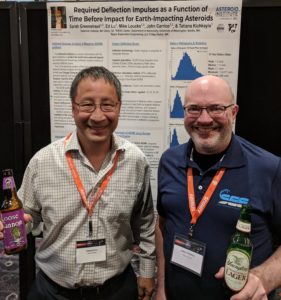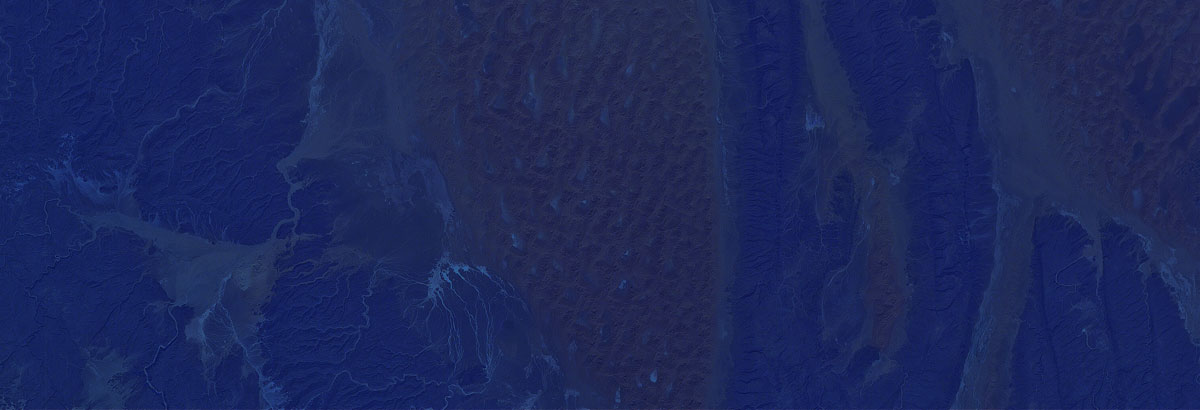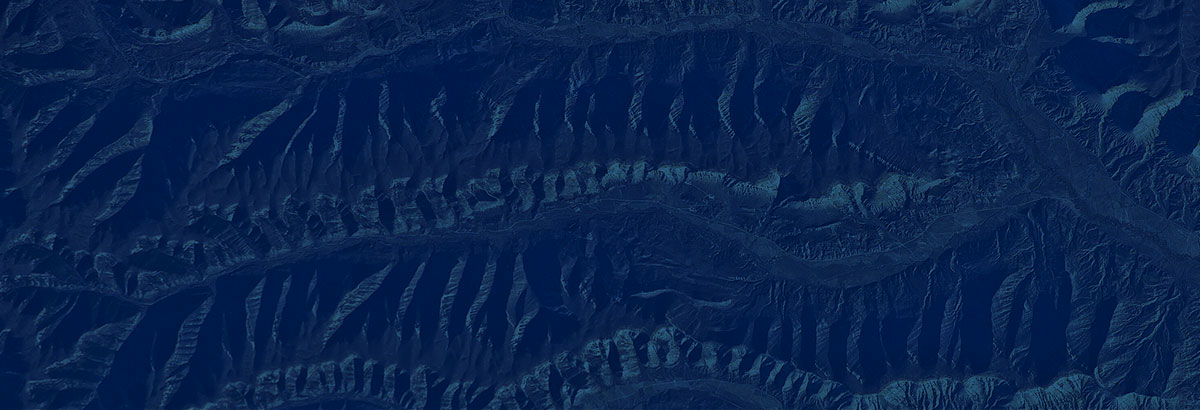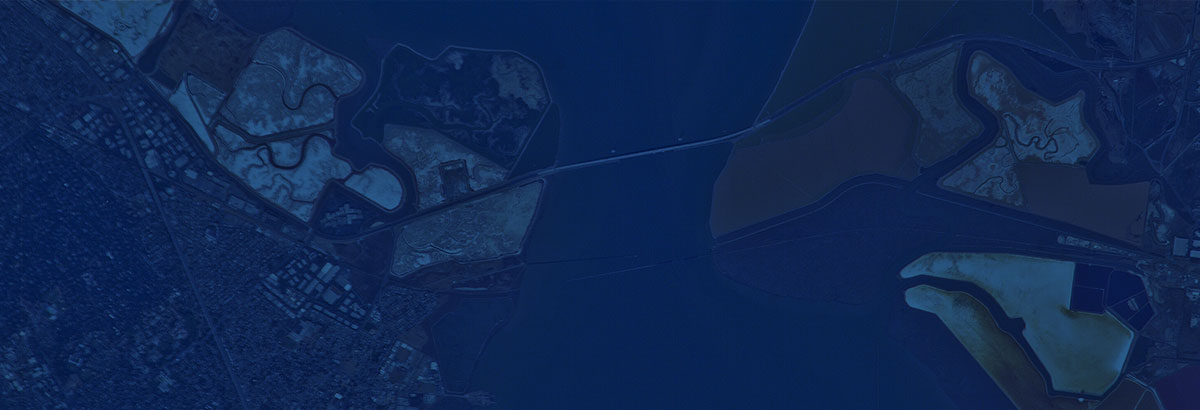The Effect of Warning Time on the Deflection of Earth-Impacting Asteroids | ADAM
May 2, 2019
 As an Asteroid Institute Researcher, I am studying how impacting asteroids need to be “nudged” (re: velocity change/ delta-v) to avoid hitting Earth.
As an Asteroid Institute Researcher, I am studying how impacting asteroids need to be “nudged” (re: velocity change/ delta-v) to avoid hitting Earth.
Through the Asteroid Decision Analysis and Mapping (ADAM) project, a Google cloud-based platform under development, I and colleagues simulate the impact avoidance of 10,000 asteroid orbits that were chosen such that they impact with Earth. These 10,000 asteroids are a representative population of Earth-impacting asteroids that closely mimics the real distribution of actual Earth-impacting asteroids. We calculate the nudge (delta-v) needed to force these impacting asteroids to miss the Earth by 4,000 miles (a distance equal to the radius of the Earth).
Our research confirms that the longer we wait to deflect an asteroid the harder it gets. This means it is important to have as much warning time as possible before an asteroid impact in order to use the smallest amount of resources to deflect the asteroid. However, the research also shows it is possible to deflect an asteroid on an impact course with the Earth in this manner with a warning time as little as ten years before impact.
We find a substantial range of delta-v is required in various scenarios, however, the vast majority of impacting asteroids require a relatively small delta-v in order to “nudge” them away from Earth.

Distributions of required deflection delta-v for 10, 20, 30, 40, and 50 years before impact. The most likely required deflection delta-v (distribution “peak”) as well as the median, mean, minimum, and maximum required delta-v for each amount of time before impact studied are also included.
Interestingly, our study finds a subset of impacting asteroids that are significantly easier to deflect than most with up to 20 times less delta-v required. These particular asteroids are extremely easy to deflect because prior to their impacts, many travel close enough to a planet (often the Earth) on an earlier pass that their paths are altered by that planet’s gravity. The result is that only a very small nudge by a spacecraft is then needed to avoid Earth. The downside to requiring a small nudge is that such asteroid impact scenarios make it difficult to determine whether a collision will actually take place due to the sensitivity of these asteroid paths over time as they interact with the planets through gravity. These situations are likely to be some of our most difficult real-world asteroid impact deflection scenarios. Understanding what fraction of the potential asteroid impact scenarios will fall into this category is an important part of understanding the asteroid impact threat. This is being studied in detail with this project.
An important advantage of performing this study using ADAM’s cloud-based technology is the significant reduction of time it takes to run calculations. Previous tests for this study were run on the desktop computer version of the software, which took months to run by calculating the required delta-v to deflect the 10,000 virtual impacting asteroids in batches of 5-10 at a time. Using our ADAM platform drastically dropped this calculation time. It now takes less than 24 hours to run all 10,000 asteroids simultaneously with ADAM. This has allowed us to perform our large-scale calculations on very short timescales.

Ed Lu and John Carrico celebrate.
In addition, we have been able to extend our study to calculate the required delta-v for all 10,000 asteroids to miss the Earth at more warning times before impact. This is the key development of our study to understanding the asteroid impact threat.
The findings of our study was presented at the Planetary Defense Conference in College Park, MD from April 29 – May 3 and will be written in a paper for publication in a scientific journal with a submission goal of Fall 2019, which is expected to result in publication in late 2019 or early 2020.
About the Author:
 Sarah is a B612 Asteroid Institute Senior Researcher. Her research interests revolves around orbital dynamics problems in the Solar System. This includes studying main-belt asteroid resonances, resonant mechanisms that create asteroids on retrograde orbits, co-orbital Solar System objects, impact and crater formation rates, near-Earth object population modelling, and Earth impact probabilities and hazard mitigation. She has also used observations of near-Earth objects to determine whether predicted asteroids undergo the Yarkovsky effect. She received her Ph.D. in 2015 from the University of British Columbia. Learn more about her work here www.sarahgreenstreet.com
Sarah is a B612 Asteroid Institute Senior Researcher. Her research interests revolves around orbital dynamics problems in the Solar System. This includes studying main-belt asteroid resonances, resonant mechanisms that create asteroids on retrograde orbits, co-orbital Solar System objects, impact and crater formation rates, near-Earth object population modelling, and Earth impact probabilities and hazard mitigation. She has also used observations of near-Earth objects to determine whether predicted asteroids undergo the Yarkovsky effect. She received her Ph.D. in 2015 from the University of British Columbia. Learn more about her work here www.sarahgreenstreet.com
Other Recent Research Papers by the Author:
April 2018 (DDA conference talk given by colleague): Two objects in Neptune’s 9:1 resonance — implications for resonance sticking in the scattering population
May 2018 (non-first-author paper published in ApJS): OSSOS. VII. 800+ Trans-Neptunian Objects—The Complete Data Release
June 2018 (non-first-author paper published in AJ): OSSOS. IX. Two Objects in Neptune’s 9:1 Resonance—Implications for Resonance Sticking in the Scattering Population
July 2018 (non-first-author paper published in Icarus): Delivery of organics to Mars through asteroid and comet impacts
Oct 2018 (DPS conference talk): A main-belt source for retrograde jovian co-orbital asteroids
Oct 2018 (DPS conference talk given by colleague): A Saturnian horseshoe coorbital & predictions for temporary coorbitals of the giant planets
Jan 2019 (Portland State University public talk to aerospace & geology groups): Retrograde asteroids: Going the wrong way around the Sun!
Jan 2019 (AAS conference iPoster – ADAM related): Required deflection impulses as a function of time before impact for Earth-impacting asteroids
Feb 2019 (paper published in Icarus): Crater Density Predictions for New Horizons flyby target 2014 MU69
March 2019 (paper published in Icarus): Measuring the Yarkovsky effect with Las Cumbres Observatory
March 2019 (LPSC conference talk given by colleague): Impact Craters on 2014 MU69: Implications for the Geologic History of MU69 and Kuiper Belt Population Size-Frequency Distributions
March 2019 (non-first-author paper published in Science): Impact craters on Pluto and Charon indicate a deficit of small Kuiper belt objects
















